|
|
Post by Deleted on Apr 9, 2020 7:24:22 GMT -5
but I suspect we all have a trashy guilty read
|
|
|
|
Post by earl on Apr 9, 2020 8:39:35 GMT -5
Reading the second half of Brandon Graham's Prophet series. It is one of the most madcap science fiction comics, just running over with crazy ideas and images. Stylistically, its more 2000 AD/Heavy Metal European in style, but there is a total Jack Kirby thing going on with all the crazy devices and creatures. Definitely too weird for everyone, but it's also not totally inaccessible and weird enough ties into old Image super hero comics.
|
|
|
|
Post by Deleted on Apr 9, 2020 9:58:58 GMT -5
Reading the second half of Brandon Graham's Prophet series. It is one of the most madcap science fiction comics, just running over with crazy ideas and images. Stylistically, its more 2000 AD/Heavy Metal European in style, but there is a total Jack Kirby thing going on with all the crazy devices and creatures. Definitely too weird for everyone, but it's also not totally inaccessible and weird enough ties into old Image super hero comics. I read the first volume circa 2013 or so and quite liked it, and have picked up volumes 2-4 but haven't gotten to them yet. -M |
|
|
|
Post by Batflunkie on Apr 9, 2020 10:14:47 GMT -5
Yes but I suspect we all have a trashy guilty read Thanks, makes me feel a whole lot better (you too Rags). The story is actually fairly entertaining for what it is, does have a lot of meta-commentary on the whole bad girl genre from the late 90's and ontop of that is a homage to Witchblade. Which I can't help but think of the 2002 Howard The Duck version, the Doucheblade, when I hear it 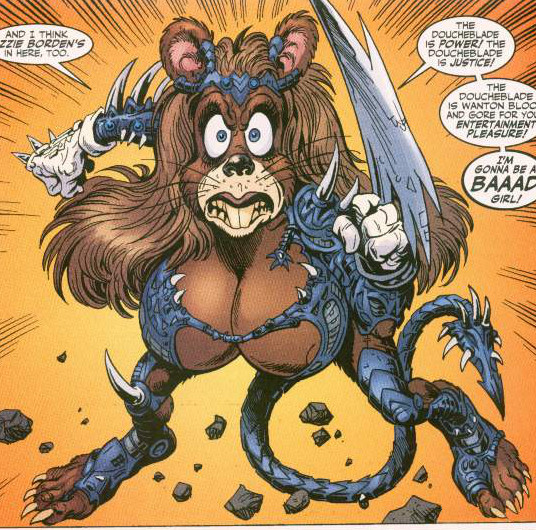 |
|
|
|
Post by berkley on Apr 9, 2020 12:39:13 GMT -5
Daniel Clowes's Mister Wonderful (2011) - not quite ten years old so just sneaks under the modern comic bar. Good enough but not great. Apparently it was expanded from a piece that Clowes serialised in the New Yorker and if the additoons are all those full page and double page spreads, most of them look out of place visually and don't add much to the story or characterisation. Other than that, it was a decent, though slight piece of work. I have a feeling it might have read better in its original serial format - which I also found to be the case even with the much superior Ghost World.
I'm expecting much better from Patience when I get around to that one, hopefully sometime over the next few months.
|
|
|
|
Post by earl on Apr 11, 2020 11:25:09 GMT -5
I've also recently read the first four volumes of the Black Hammer comic. It's a good series. I don't know that I liked it as much as some reviewers have, but it's smart and well done.
|
|
|
|
Post by Deleted on Apr 15, 2020 1:38:05 GMT -5
Normandy Gold, a Hard Case Crime Comics...   written by Alison Gaylin and Megan Abbot. Art by Steve Scott, Rodney Ramos and Lovern Kindzierski The writers are a pair of Edgar nominated (and in one case winning) authors who know their way around a crime story or three, and it shows. The art by Scott is luscious and simply eye candy. I wasn't familiar with his stuff before this, but I liked it here a lot. It reminded me in some ways of Steve Epting's work on Velvet. The entire creative team was going for a 70s thriller feature vibe, and it worked. It oozes in 70s culture and excesses, from presidential politics of the early 70s, to drug culture, shadow governments, sex clubs, crooked cops, good cops, and bad-ass vigilantes. If I were going for an elevator pitch it would be Pam Grier meets All The President's Men. It's not a perfect comic, and has some flaws, but it is a fun, gripping read that hits all the right notes if you are into 70s crime, culture or films. -M |
|
|
|
Post by String on Apr 19, 2020 14:03:09 GMT -5
I received my last batch of new comics from my LCS before they had to shut down.
Slott has injected some great heart and humor into Fantastic Four where he just completed an arc that revealed some surprising new information about their origin (and Johnny has acquired a new soulmate. Cue the Crystal jokes).
Aaron brings some recent plot threads together in Avengers as Earth's Mightest Villains seek to unite to combat the team and their influence. This comes after his recent arc where the team headed towards a Sh'iar prison galaxy to eventually rescue the new bearer of the Star Brand. This title hasn't been this entertaining in quite some time, love it.
Meanwhile, Ed Brisson is putting Johnny Blaze through the motions over in Ghost Rider. The new King of Hell is determined to resolve a demon uprising and breach unto Earth one way or the other even if it means working with Mephisto. Danny Ketch has lost the Spirit of Vengeance but has gained the Spirit of Corruption which he'll need to face off against his brother. And while the King is away, Lilith, Belasco, and Blackheart race to see who can usurp the throne first. With some terrific art by Kuder, this title has been fun so far.
The last issue of Avengers/Defenders Tarot mini-series came in. Written by Alan Davis, art by Paul Renaud, this has been a fun mini with plenty of old-school warmth and humor. Both teams are drawn into conflict against Diablo who fashions tarot cards using mind-controlling demon ichor as ink. Chaos, havoc, mash-ups and a cartoon group of superheroes named the Unbelivables ensue. It's just been a treat to read.
Hawkman - Pasarin's art is stunning, love it. V-ditti is still rocking with this current story arc of the Sky Tyrant in control of Carter's body. With the help of Atom and Adam Strange, Hawkwoman seeks to free Carter from this evil influence. But what happens after Hawkwoman is finally made aware of all of her previous lives through space and time? ARGH, this last issue ends on a cliffhanger no less!
Legion of Superheroes - I'm trying to support this book but it's getting tough. Bendis' pacing is ssslllooooowwww. Five issues to learn why Jon Kent is there, really? Some focus on more of the team members would be appreciated (like can Triplicate Girl merge into one body or not? All we've seen are her three separate bodies. Invisible Kid was previously said to be Lyle but here it's Jacques. Which is it?) The art by Sook remains great though.
|
|
|
|
Post by wildfire2099 on Jun 12, 2020 0:04:51 GMT -5
Finally got to Superman smashes the Klan... brilliant. Great story, great characters... it even explains how Superman starting flying (which is great).
I think in my official head canon of the DCU, Robert (Lan-shin) Lee is related to Maps(from Gotham Academy) somehow.... I loved her!
|
|
|
|
Post by Deleted on Jun 12, 2020 0:15:14 GMT -5
Finally got to Superman smashes the Klan... brilliant. Great story, great characters... it even explains how Superman starting flying (which is great). I think in my official head canon of the DCU, Robert (Lan-shin) Lee is related to Maps(from Gotham Academy) somehow.... I loved her! It is a great series and one of my favorite takes on Superman (sorry Slam_Bradley). It feels like it could be the Superman of the Fleisher cartoons. -M |
|
|
|
Post by wildfire2099 on Jun 12, 2020 0:16:44 GMT -5
Most definitely! And don't apologize to Slam... this is actually the version of Superman he can get behind (at least until the last few pages)
|
|
|
|
Post by Roquefort Raider on Jun 14, 2020 14:49:58 GMT -5
I've just read the second collection of Aaron and Asnar's Conan the barbarian.
It's... O.K. It's a fair comic, with nice art and engaging stories. However, what worried me after the first six issues is confirmed: this is not a continuation of Marvel's earlier career at Marvel, but a reboot. A soft reboot, to be sure but a reboot nevertheless. Major points from the old series have been changed (Conan's relations with Thoth-Amon, with King Yezdigerd, and also Bêlit's origins being first among them. This is by far the worst Thoth-Amon I've seen, including the one from the second movie).
I honestly don't see the point. Dark Horse had rebooted Conan too, but with a clear agenda: adapting Robert Howard's stories from scratch, ignoring earlier adaptations and pastiches, and trying to remain as true to the writer's original vision as possible. Here we get an attitude of "well, whatever, man... we're gonna use what we feel like using and ignore the rest".
Aaron is a good writer with a pretty good ear for dialog, but some ideas used here (beyond the continuity issues) should have been vetted by an editor.
The script is obviously informed by our modern sensibilities, to the point of being distracting. I guess it makes sense if your audience is a young readership with no familiarity with the older comics or with the prose work, so it might be unavoidable... alas. One example: Conan goes to an extremely seedy part of the world to recruit prostitutes whom he intends to use in some scheme of his. Their being attractive would suffice for the plot. Naturally, of course, all of them turn out to be intelligent, resourceful, witty and extremely resourceful on top of being drop-dead gorgeous (and of multiple ethnic origins); one is a ninja, another is a brilliant hunter, and all of them manage to decimate a cohort of armoured bodyguards while themselves wearing silk bikinis... Why in Crom's name would such gifted and accomplished badasses sell their body in a crummy neighbourhood in the ass-end of the world in the first place? It just makes no sense. It would have been better had these ladies been the new version of the Iron Damsels, an all-female band of mercenaries from the earlier runs.
I wanted to see how the story arc "the life and death of Conan" would turn out. Now that I have, I won't make mine Marvel anymore when it comes to Conan... I'll stick to Glénat.
|
|
|
|
Post by Deleted on Jun 16, 2020 3:04:38 GMT -5
I just read the graphic novel adaptation of Octavia Butler's Parable of the Sower done by Damian Duffy and John Jennings (one half the art collective known as Black Kirby tat I have discussed elsewhere on these boards) published by Abrams ComicArts in 2020.  Here are Duffy and Jennings in front of a stack of pages of Jennings' art... 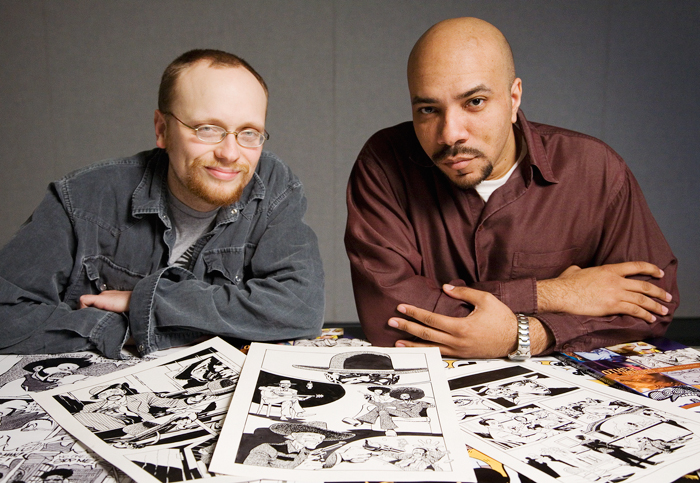 and here's a couple of sample pages to give a feel of the look of the book before I comment. I show these not only to sample the book, but also to show that Jennings isn't a one-trick pony artistically, and these are a very different style than the Kirby-infused art he was doing for Black Kirby.   This is their second GN adaptation of Butler's works, the first being The Kindred, which garnered a lot of critical success and awards. Octavia Butler's name has been ubiquitous since I began my delve into the realm of Afrofuturism (one of the trinity of foundation stones for the movement that pre-dated the movement along with Sun Ra and George Clinton). I was familiar with her name before I began my exploration, but not her work. I have already read Dawn, the first book of her Xenogenesis trilogy, in prose and wanted to explore more, and when I searched my library's catalog for a copy of the Parable books (there's a sequel, Parable of the Talents, which Duffy and Jennings are working on adapting now as well), they only had the GN not the novel in their catalog, but seeing Jennngs name attached, I was intrigued and decided to give it a try, and I am glad I did. Butler creates a near-future dystopian world set in California in 2024-2027. It was written in 1993, but Butler's vision of the future is hauntingly realistic and are reflected in the headlines of 2019 and 2020. The protagonist is a young black girl, Lauren Olamina, who is 15 at the start of the story. She is the daughter of a baptist preacher, but her mother was a rug addict and a a result of drug abuse during her pregnancy, Lauren suffers from hyperempathy, i.e. she feels the pain and pleasure of those around her. She and her family live within a walled community in Southern California, and the book follows the events over a four year span. Lauren does not share her father's beliefs and through her experiences, she begins to conceive of a new philosophy/religion called Earthseed, which revolves around the tenet that God is change, and whatever we change, changes us. God is not to be worshiped, but can be shaped just as it shapes us, and that our ultimate destiny is in stars, but we mush shape the change to come. When the community is eventually attacked and destroyed, Lauren begins a new journey and gathers folks around her who slowly begin the listen and accept her message of Earthseed. The book is not preachy, it's not promulgating a new religion, but it is examining the human condition, the hardships and joys of life, the precipitous future we face and how we might react, the need for community, the inhumanity people can show to others, and how new systems of thought can take root and give hope in such situations. I've not read the prose novel yet (I will when I can), so I can't speak to how faithful Duffy was in his adaptation, but the Kindred adaptation has a rep of being extremely faithful to Butler's novel so I expect this too is very faithful. And I look forward to reading the sequel (The Parable of Talent) when I can (wither the novel or the GN when Duffy & Jennings finish it (I have already tracked down a copy of the Kindred GN and added it to my TRR list). Butler planned a third book, but died before she could start it, so it is an unfinished trilogy, but the first book at least is good enough to stand on its own and well worth checking out in some format. Jennings art has a distinct look here. It portrays an ugly world and has a purposeful ugliness to parts of it, but there is a beauty in his art as well. His visual storytelling is strong. If you are looking for mainstream comic book style art you would find as a house-style in a big 2 book, you won't find what you are looking for here, and that style would be completely inappropriate for the subject matter. Jennings art fits the mood and tone of the book to a tee. It is stylized, makes use of some "cartoonish expressionism" to convey some of the horrors the characters experience and their reaction to it, but it all feels very realistic and at time horrific when the events call for it. The story is amazing. Parable of the Sower is one of those books once read, you will never forget, whether you love it or hate it. It is a seminal work and a watershed story. One I highly recommend checking out in any format. For those who enjoy comics outside the niche hobby "mainstream" of direct market super-hero comics, the graphic novel is a phenomenal read as well. -M |
|
|
|
Post by wildfire2099 on Jun 16, 2020 23:35:41 GMT -5
Read vol 2 of Morrison's Green Lantern, I guess this is 'season 1'. He tries to tie it into the Multiversity stuff, but it fell totally flat for me. I don't need Bizzaro Hal Jordan. Liam Sharp's art is fantastic though. Then there's the fact that the there's a cliffhanger ending, then a fill-in to end the volume.
I keep thinking surely if I read more of him I'll 'get' it, but I really just don't like him.
|
|
|
|
Post by Deleted on Jul 5, 2020 12:41:20 GMT -5
After reading Parable of the Sower, I tracked down Jennings and Duffy's adaptation of Octavia Butler's The Kindred... 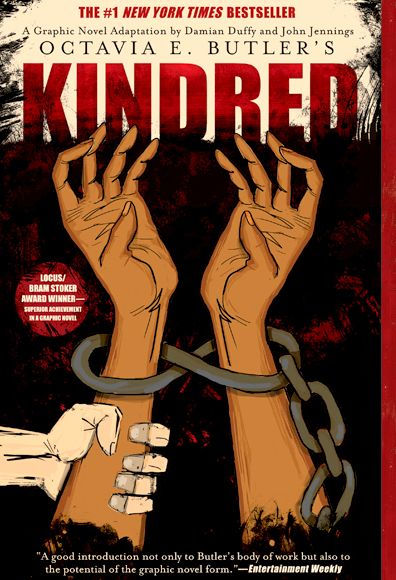 Dana and Kevin are a mixed couple living in the mid-1970s, both are writers and they are just beginning their careers and life together, when Dana has an episode and finds herself transported back in time to Maryland of the early 1800s, and saves the life of a young white boy, Rufus Weylin, who turns out to be her ancestor, and is mistaken as an escaped slave before she loses consciousness and returns to her own time. She has multiple episodes each time Rufus is in danger, and her husband Kevin is transported back with her the third time, and is eventually trapped in the past when Dana returns without him on their fourth trip. Dana continues to be pulled back into the past, struggling to keep Rufus alive to start here family line, living as a slave and trying to find her husband. This is a gut-wrenching narrative. It is a powerful examination of slave culture from a modern black perspective, and nominally science fiction as it is a time-travel story, but at its core it is a moving story about people and relationships. Butler is a master of crafting real believable characters and Duffy and Jennings capture that so well in their adaptation. The prologue starts at the end of the story with this opening panel...  and we proceed to learn the whys and wherefores as the story goes along. The GN is broken into chapters/sections, each one corresponding to one trip back to the past and the eventual return to the present. E see the supporting cast in the past grow and age as months and years pas between trips even though only a few days pass in the present. There are so many scenes I could touch upon, but without the context of actually reading the story, they might just seem like rambling. The language is harsh, but appropriate for the time period it is set, and the future characters comment on the language's harshness as part of the social commentary inherent in the story. Just a couple of sample pages (trying to find pages without the harsh language but that convey the feel of the story)... 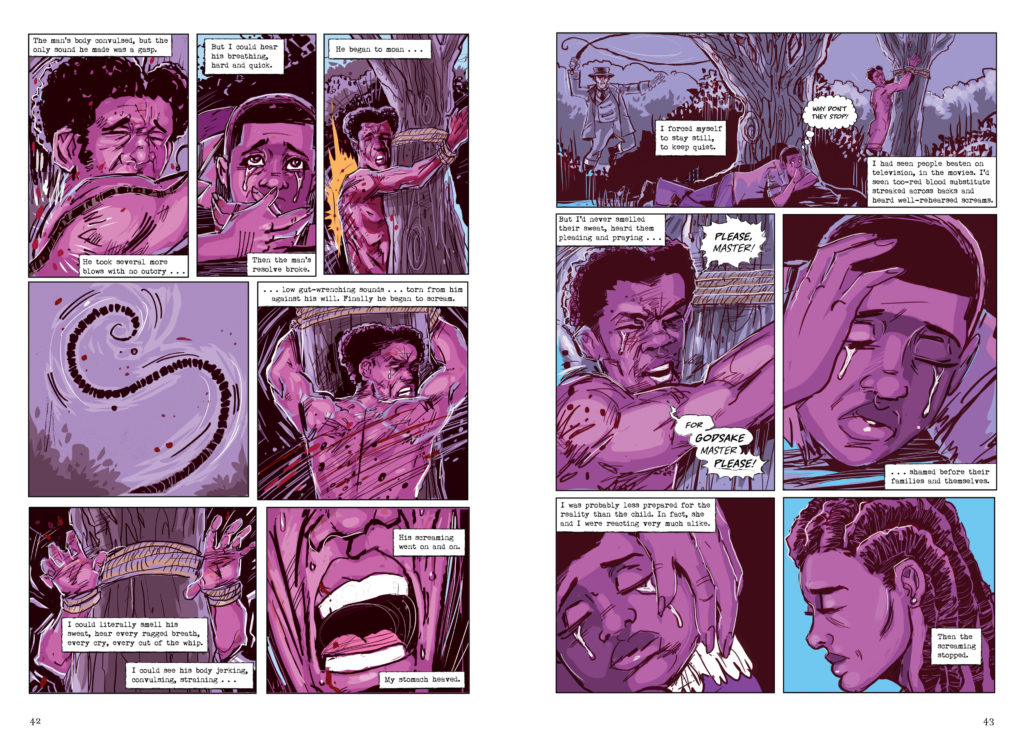 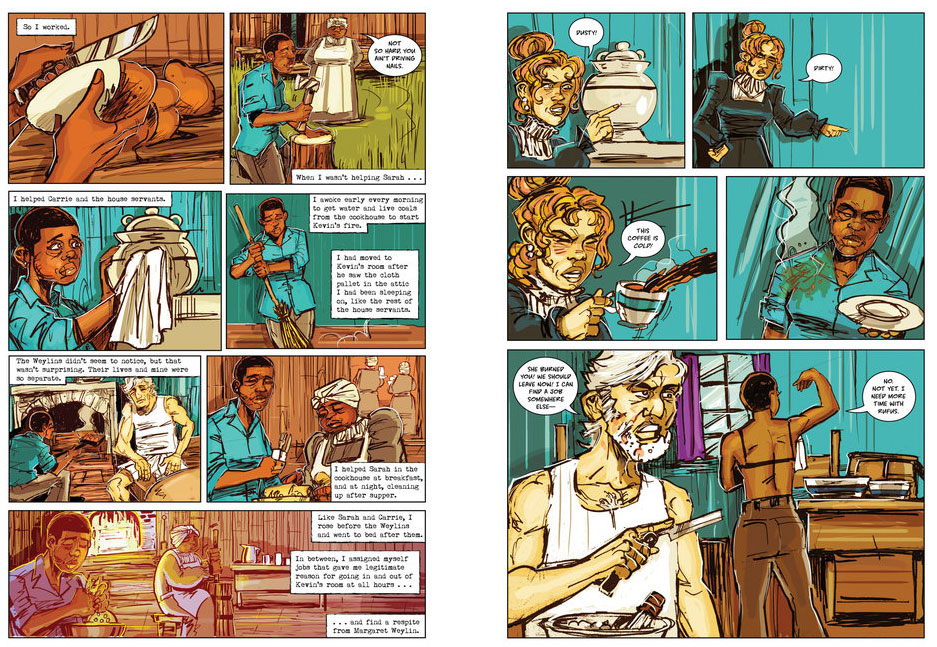 Reading this is like a punch to the gut at times. Powerful, gripping, enlightening, and thought-provoking. -M |
|